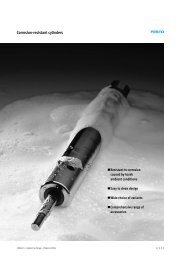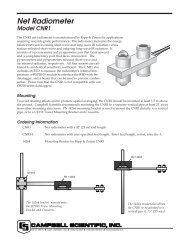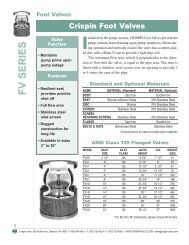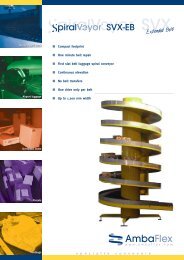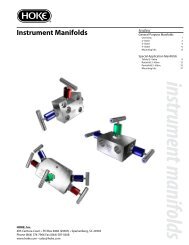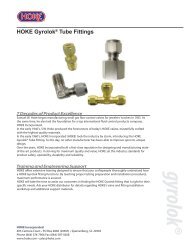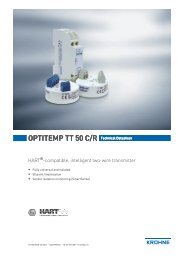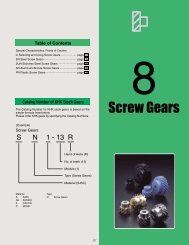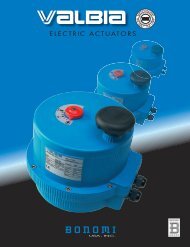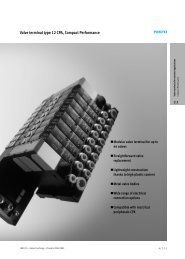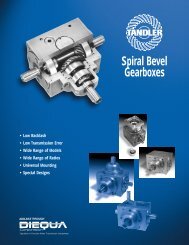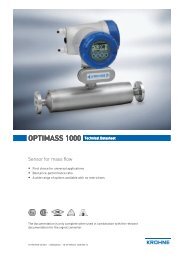How to Choose and Use Magnetic Separators - Zycon
How to Choose and Use Magnetic Separators - Zycon
How to Choose and Use Magnetic Separators - Zycon
You also want an ePaper? Increase the reach of your titles
YUMPU automatically turns print PDFs into web optimized ePapers that Google loves.
SB-95A<br />
Ask Orange TM<br />
Provides solutions<br />
<strong>to</strong> process problems<br />
<strong>How</strong> To<br />
<strong>Choose</strong> & <strong>Use</strong><br />
<strong>Magnetic</strong><br />
Separa<strong>to</strong>rs<br />
Complete guide <strong>to</strong><br />
<strong>Magnetic</strong> Materials <strong>and</strong><br />
Separation Equipment<br />
It’s not magic...it’s ERIEZ<br />
World authority in advanced<br />
technology for magnetic, vibra<strong>to</strong>ry<br />
<strong>and</strong> inspection applications.
<strong>How</strong> To <strong>Choose</strong> <strong>and</strong> <strong>Use</strong> <strong>Magnetic</strong> Separa<strong>to</strong>rs<br />
Page<br />
Introduction 1<br />
1. Magnet Materials & Styles 2<br />
2. Application Considerations 4<br />
3. Type of Material being Processed 4<br />
4. Separation Equipment - Plate Magnets 5<br />
5. Separation Equipment - Grate Magnets 7<br />
6. Separation Equipment - Liquid Line Trap Magnets 7<br />
7. Separation Equipment - Pneumatic Line RF Magnets 8<br />
8. Separation Equipment - Suspended Magnets 8<br />
9. Separation Equipment - <strong>Magnetic</strong> Pulleys <strong>and</strong> Drums 11<br />
10-. Separation Equipment - High Intensity <strong>Magnetic</strong>s 11<br />
11. Separation Equipment for NonFerrous Metals 12<br />
Ask Orange TM is a collection of process solution<br />
case studies <strong>and</strong> how-<strong>to</strong> reference manuals<br />
designed <strong>to</strong> improve underst<strong>and</strong>ing <strong>and</strong> simplify<br />
specifying sophisticated magnetic, vibra<strong>to</strong>ry<br />
<strong>and</strong> metal detection equipment needed in most<br />
process industries. Most of this equipment<br />
requires an underst<strong>and</strong>ing of its intended use in<br />
order <strong>to</strong> determine proper application.<br />
The “Professor” icon has been developed <strong>to</strong> help cus<strong>to</strong>mers identify Ask<br />
Orange TM material in printed trade publications, company literature <strong>and</strong> on<br />
its web site. The Ask Orange concept <strong>and</strong> related images are a tribute <strong>to</strong><br />
the company’s founder, Orange F. Merwin, <strong>and</strong> his innovative ideas using<br />
magnets <strong>to</strong> remove metal contamination from various process flows.<br />
®
<strong>How</strong> To <strong>Choose</strong> <strong>and</strong> <strong>Use</strong> <strong>Magnetic</strong> Separa<strong>to</strong>rs<br />
The use of magnets for removing ferrous contaminants in an industrial<br />
environment first began in the 1940s when Orange F. Merwin developed a flat<br />
magnetic product <strong>to</strong> help farmers trap <strong>and</strong> remove metal contaminants from<br />
their grain chutes. At the time, unwanted or “tramp” metal in the grain flow often<br />
created a spark that would ignite the explosive dust causing fires… sometimes<br />
with catastrophic results. Orange’s early version of <strong>to</strong>day’s plate magnet was a<br />
huge success <strong>and</strong> led <strong>to</strong> the founding of Eriez <strong>Magnetic</strong>s. After more than 60<br />
years, Eriez remains the world’s authority in magnetic separation solutions for<br />
industry.<br />
Ferrous metal contamination damages process equipment <strong>and</strong> creates impure<br />
product that must be scrapped or sold at less than full value. This metallic<br />
contamination may come from a variety of sources. Incoming products may<br />
contain contaminants from the transportation vessel used <strong>to</strong> deliver the product,<br />
such as a truck bed, rail car, barge or ship hold. The contamination may originate<br />
within the plant due <strong>to</strong> material processing, grinding, crushing or general abrasion.<br />
The problems associated with ferrous metal contamination can be reduced or<br />
eliminated by using magnetic separation equipment. <strong>Magnetic</strong> Separa<strong>to</strong>rs,<br />
available in a wide variety of designs, will remove ferrous material such as nails,<br />
rust, scale, bolts, welding rod <strong>and</strong> other contaminants from dry or liquid products.<br />
The proper use of this equipment will reduce or eliminate metallic contamination<br />
from the process.<br />
Selecting the proper magnetic separa<strong>to</strong>r requires an underst<strong>and</strong>ing of magnetic<br />
properties, the process application <strong>and</strong> environmental elements that exist in each<br />
specific installation. This guide provides a basic underst<strong>and</strong>ing of how <strong>to</strong> choose<br />
the proper magnetic separa<strong>to</strong>r for different process requirements. Beginning<br />
with a magnet material overview, <strong>How</strong> <strong>to</strong> <strong>Choose</strong> <strong>and</strong> <strong>Use</strong> <strong>Magnetic</strong> Separa<strong>to</strong>rs<br />
covers various types of materials being processed, numerous magnetic separation<br />
techniques, application considerations <strong>and</strong> a wide variety of magnetic separation<br />
equipment currently available.<br />
Did you know<br />
In order <strong>to</strong> help cus<strong>to</strong>mers select the proper equipment, Eriez<br />
operates the industry’s largest labora<strong>to</strong>ry of magnetic separation<br />
equipment. Here, materials are sampled <strong>to</strong> ensure product<br />
<strong>and</strong>/or process purity that meets each cus<strong>to</strong>mer’s specific<br />
requirements. Contact your Eriez representative <strong>to</strong> arrange<br />
a sampling. Tour the lab at eriez.com, click: Tour Eriez - USA<br />
© 2007 ERIEZ MAGNETICS ALL RIGHTS RESERVED<br />
1
1. Magnet Materials & Styles<br />
Permanent<br />
Magnet material generally refers <strong>to</strong> the magnetic pressings or castings used <strong>to</strong><br />
develop the magnetic field within the separa<strong>to</strong>r. This material may be cut <strong>and</strong><br />
arranged in a linear fashion using other materials <strong>to</strong> create a magnetic circuit.<br />
Depending on the desired outcome, circuits may be designed <strong>to</strong> cast a shallowwide<br />
magnetic field; a deep-narrow field or anywhere in between. This is why it<br />
is often difficult <strong>to</strong> compare competing products made of only similar material.<br />
Once the circuit is assembled, it is usually encased within stainless steel <strong>to</strong><br />
protect the magnet material from wear associated with product flow, damage or<br />
from contaminating the feed material.<br />
Since the 1940s, there has been substantial change in the materials used <strong>to</strong><br />
manufacture permanent magnetic separa<strong>to</strong>rs for industry. The following is a brief<br />
description of the most common magnetic materials used over the past 60-plus<br />
years.<br />
Alnico<br />
Alnico is one of the earliest magnet materials used for ferrous separation.<br />
These magnets are commonly recognized by their horseshoe shape. This<br />
material is a casting of Aluminum, Nickel, Cobalt <strong>and</strong> Iron. Although seldom<br />
used <strong>to</strong>day, as there are more economical magnet sources, Alnico may still be<br />
used in applications involving temperatures in excess of 400 degrees Fahrenheit<br />
(204 degrees Celsius). This material is comparable in strength <strong>to</strong> ceramics <strong>and</strong><br />
used <strong>to</strong> remove relatively large pieces of ferrous metals, such as nuts or bolts.<br />
Ceramic<br />
During the 1960s, problems in South Africa drove up the price of Cobalt forcing<br />
manufacturers <strong>to</strong> search for an Alnico substitute. It was then that manufacturers<br />
began using Ferrite ceramic pressings in their magnetic assemblies. Ceramic<br />
pressings are easy <strong>to</strong> work with because they can be cut in all directions,<br />
assembled in<strong>to</strong> a circuit <strong>and</strong> then charged as a complete unit. Ferrite pressings<br />
became the st<strong>and</strong>ard in permanent magnetic separa<strong>to</strong>rs until the early 1980s.<br />
Ceramic magnet circuits work best when the goal is <strong>to</strong> remove relatively large<br />
pieces of ferrous metal contamination.<br />
Did you know<br />
The strength of the field produced by a magnet<br />
is usually measured in units called Gauss. Very<br />
strong magnetic fields may be measured in units<br />
of Tesla, where 1 Tesla equals 10,000 Gauss.<br />
For refrence, the magnetic field of the Earth is<br />
about 0.5 Gauss.<br />
2
Rare Earth<br />
The term, Rare Earth, is a misnomer. A rare earth magnet derives its name not<br />
because it is rare, nor because it is earth. It is named “Rare Earth” because part<br />
of its make-up is one of the Lanthanide elements of the Periodic Table between<br />
57 <strong>and</strong> 71. There are 14 elements referred <strong>to</strong> as “The Rare Earth Elements.”<br />
Samarium Cobalt was the first such material used in the early 1980s. The<br />
next material on the market was Neodymium Iron Boron, called “Rare Earth”<br />
because Neodymium, like Samarium, is one of the Lanthanides. Today, Rare<br />
Earth magnetic circuits produce a magnet force more than 10 times that of<br />
ceramic magnetic circuits. The graph below provides a his<strong>to</strong>ry of magnetic<br />
material improvements.<br />
Eriez’ Rare Earth Material develops an extremely high surface force <strong>to</strong> enable<br />
the magnetic circuit <strong>to</strong> remove very fine or weakly magnetic contamination such<br />
as rust, scale or even work-hardened stainless steel from a product flow. High<br />
strength Rare Earth Separa<strong>to</strong>rs are extensively used by food, chemical <strong>and</strong><br />
pharmaceutical processors requiring the highest levels of product purity.<br />
Electromagnets<br />
For larger industrial separation applications, Eriez developed electromagnetic<br />
separa<strong>to</strong>rs. The popular round-core electromagnet uses round aluminum or<br />
copper wire in an oil-filled assembly <strong>to</strong> generate a powerful electromagnetic<br />
field. These electromagnets efficiently remove ferrous metals in heavy industrial<br />
applications like coal, limes<strong>to</strong>ne, s<strong>and</strong> <strong>and</strong> other aggregates.<br />
These large scale magnets are available in a variety of configurations including<br />
oil <strong>and</strong> air-cooled; round, hollow <strong>and</strong> rectangular core; explosion proof; even<br />
cryogenic superconducting magnets capable of producing the world’s strongest<br />
magnetic force for separation applications.<br />
3
Did you know<br />
Eriez was the maker of the World’s Strongest Suspended<br />
Electromagnet operating at China National Coal in Qingdao. This<br />
Superconducting Electromagnet produces 4000 gauss at<br />
550mm (21.65 inches). That’s nearly twice the strength of any<br />
similar magnet! See it at eriez.com, click: Press Room - 3/15/02<br />
2. application considerations<br />
Temperature<br />
Permanent magnetic materials lose strength when exposed <strong>to</strong> elevated<br />
temperatures. Some losses are reversible in that when the temperature is returned<br />
<strong>to</strong> normal, the magnetic strength returns. Permanent magnets heated beyond<br />
certain temperatures (which depend on the specific material) may also suffer<br />
irreversible loss: a reduction in strength that cannot be recovered by cooling.<br />
When specifying a magnet application, it is important <strong>to</strong> note the ambient as<br />
well as any Clean in Place (CIP) temperatures <strong>to</strong> ensure a proper magnet design<br />
suitable for long term separation performance.<br />
Flow Rate<br />
<strong>Magnetic</strong> separa<strong>to</strong>rs perform best when the contamination is presented <strong>to</strong> the<br />
surface of the separa<strong>to</strong>r. It is best <strong>to</strong> select a magnetic separa<strong>to</strong>r that provides for<br />
a thin burden depth over or under the magnet <strong>to</strong> ensure the magnet will have the<br />
best opportunity <strong>to</strong> capture the ferrous contamination.<br />
Flow Characteristics<br />
Many products exhibit different flow characteristics when damp or moist. Are<br />
there large chunks that may plug an opening or gap in the separa<strong>to</strong>r Will the<br />
product flow freely through the selected magnetic separa<strong>to</strong>r For example, brown<br />
sugar with any significant moisture content will not flow between the tubes in a<br />
grate magnet assembly, although they may be positioned nearly one inch (25mm)<br />
apart from each other.<br />
Process Issues<br />
<strong>How</strong> will the material be presented <strong>to</strong> the separa<strong>to</strong>r Is the material metered<br />
or do we need <strong>to</strong> h<strong>and</strong>le a surge flow Can the system be s<strong>to</strong>pped for cleaning<br />
or is a self-cleaning magnet required Is access available for cleaning Is there<br />
ferrous material in the area that may create a hazard for magnet h<strong>and</strong>ling<br />
<strong>How</strong> much contamination is <strong>to</strong> be removed And finally, what level of product<br />
purity is required<br />
3. Type of Material being Processed<br />
4<br />
Assessing the material being processed is a key step in selecting the proper<br />
magnetic separa<strong>to</strong>r. Product generally falls in<strong>to</strong> three different categories: dry,<br />
moist or liquid. Within each of these groups a wide range of product variation<br />
exists. For example, dry product ranges from tiny food grains flowing down a<br />
chute <strong>to</strong> large mined rock moving along a high-speed conveyor. These vastly<br />
dissimilar processes require different separation equipment.
Dry Free-Flowing, granular-type product<br />
If the material is small <strong>and</strong> free-flowing, a grate magnet may provide the best<br />
opportunity for the ferrous contamination <strong>to</strong> contact a magnet directly. Grates<br />
can be cleaned best for vertical product flows, while plate magnets will work well<br />
if the material is cascading down a chute. These cleaning methods require that<br />
the product flow be s<strong>to</strong>pped when removing collected iron from the magnet.<br />
Pneumatic flows of free-flowing product work best in a magnetic hump or Radial<br />
Field Cartridge. These products also require the suspension of product flow for<br />
cleaning.<br />
Drums, pulleys, <strong>and</strong> suspended magnets can provide for continuous au<strong>to</strong>matic<br />
removal of tramp metal (tramp refers <strong>to</strong> rogue metallic contamination) without<br />
needing <strong>to</strong> s<strong>to</strong>p the flow. These units provide for 24/7 removal of ferrous<br />
contamination.<br />
Dry Product with some bridging characteristics<br />
While grates provide for very efficient removal of fine metallic contamination<br />
they do not work if the material cannot cascade between the magnetic tubes.<br />
Plate Magnets do not restrict the flow of material <strong>and</strong> will not contribute <strong>to</strong> the<br />
bridging (building up of material) problem if installed beneath a sloped chute.<br />
<strong>Magnetic</strong> humps are available for less than free flowing products as long as the<br />
material will cascade down a sloped chute. Suspended magnets <strong>and</strong> pulleys may<br />
also work well if the material is conveyed with a belt conveyor or vibra<strong>to</strong>ry feeder.<br />
Moist, Starchy or Lumpy Products<br />
These products - such as flour or starch - do not flow through grate assemblies<br />
due <strong>to</strong> bridging, nor chutes due <strong>to</strong> a high angle or repose. The best options<br />
include a Deep Reach Separa<strong>to</strong>r or a Rota-Grate ® assembly. The Deep Reach<br />
Separa<strong>to</strong>r is completely out of the product flow. The Rota-Grate’s continuous<br />
rotation through products eliminates bridging problems <strong>and</strong> allows product <strong>to</strong><br />
flow freely.<br />
Liquid or Slurry Products<br />
Products in a liquid or slurry state require the use of a magnetic trap. Traps are<br />
available in either a grate or plate type configuration. Many traps are built similar<br />
<strong>to</strong> grates in that tube magnets are arranged perpendicular <strong>to</strong> the flow inside in<br />
the body of a casting <strong>to</strong> “trap” any ferrous materials passing through. A U-Trap<br />
employs a flat plate magnet in a shallow body so as <strong>to</strong> minimize damage <strong>to</strong> the<br />
product flowing past. U-Traps are ideal for chunky-flow applications.<br />
4. Separation Equipment - Plate Magnet Designs<br />
Plate Magnets are used in the bot<strong>to</strong>m of an inclined chute or suspended above<br />
a thin burden of material on a belt conveyor or stainless steel vibra<strong>to</strong>ry feeder<br />
<strong>to</strong> remove occasional pieces of ferrous contamination. Eriez’ Ceramic Magnet<br />
models like the Super, Maxi, Brute or Super Brute Power plates are effective in<br />
5
emoving relatively large ferrous material such as nuts,<br />
bolts, staples, <strong>and</strong> welding rod from a dry product flow.<br />
Rare Earth models will do a much better job on very fine or<br />
weakly magnetic contamination such as rust or scale. In a<br />
typical chute installation, the magnetic material adheres <strong>to</strong><br />
the magnet face while the product slides across the face of<br />
the magnet. The magnetic field attracts <strong>and</strong> holds ferrous<br />
material until the plate is removed for cleaning. The magnet<br />
is usually hinged <strong>and</strong> swung away from the chute <strong>and</strong><br />
cleaned manually. Plate Magnets are simple <strong>and</strong> economical<br />
<strong>to</strong> install as well as very efficient at removing occasional<br />
pieces of tramp metal.<br />
Round Pipe Separa<strong>to</strong>rs (RPS) are actually plate magnets<br />
with a fabricated transition from a round pipe <strong>to</strong> the<br />
rectangular chute that contains the Plate Magnet. The RPS<br />
consists of an inlet transition <strong>to</strong> match the existing pipe or<br />
tubing, a neoprene deflec<strong>to</strong>r <strong>to</strong> deflect the product against<br />
the plate magnet then transitions back <strong>to</strong> the chute. The<br />
material flow must be s<strong>to</strong>pped <strong>to</strong> clean the accumulated<br />
tramp metal from the plate magnet<br />
Hump Magnets are similar <strong>to</strong> the Round Pipe Separa<strong>to</strong>rs<br />
except Eriez provides the fabricated chute <strong>and</strong> two plate<br />
magnets instead of one. This extra plate effectively doubles<br />
the chances of collecting ferrous material. The Hump<br />
consists of a dogleg chute that allows the product stream<br />
<strong>to</strong> cascade from one magnetic plate <strong>to</strong> another as material<br />
moves through the dogleg. Units are available for pressure,<br />
vertical or horizontal pneumatic applications. The material<br />
flow must be s<strong>to</strong>pped <strong>to</strong> clean each plate. Self-cleaning<br />
units are also available <strong>to</strong> cycle the plate magnet away from<br />
the flow so that a stripper may au<strong>to</strong>matically remove the<br />
accumulated tramp metal contamination from the plates.<br />
Plates are in<br />
cleaning<br />
position.<br />
Deep Reach Separa<strong>to</strong>rs use a plate magnet style circuit<br />
but incorporate it in<strong>to</strong> a vertical chute. These units work<br />
well when sticky products do not readily flow down sloped<br />
chutes or when headroom is at a minimum. Two large<br />
magnet assemblies are fixed <strong>to</strong> opposite sides of a stainless<br />
steel chute <strong>and</strong> attract ferrous contamination as material<br />
flows by the chute. The magnetic circuit is designed for an<br />
exceptionally deep reach in<strong>to</strong> the product flow which makes<br />
these separa<strong>to</strong>rs effective at removing large, chunky tramp<br />
metal.<br />
6
5. Separation Equipment - Grate Magnet Designs<br />
Grate Magnets consist of one-inch diameter<br />
(25mm) magnetic tubes in a grid formation<br />
designed <strong>to</strong> allow feed material <strong>to</strong> cascade through<br />
the grate, effectively spreading magnetic protection<br />
through the cross sectioned area of a pipe, chute<br />
or hopper. Ceramic Magnet models are effective<br />
in removing relatively large ferrous contamination<br />
such as nuts, bolts or staples. Rare Earth models<br />
will do a much better job on fine or weakly<br />
magnetic material such as rust or scale.<br />
There are a variety of grate magnet designs<br />
available for almost any application. The simplest<br />
of these incorporate a single layer for use in a<br />
hopper so raw materials must pass through the<br />
grates as material feeds from the hopper. Multiple<br />
row units improve separation effectiveness. Some<br />
applications will utilize a single row of magnets<br />
<strong>and</strong> incorporate them in<strong>to</strong> a grate housing<br />
assembly of the user’s design. Eriez will also<br />
fabricate housings that include one or multiple rows<br />
of magnetic grates, depending on the level of protection<br />
required for the application. These units are<br />
common for vertical chutes of free flowing materials.<br />
Eriez’ many grate-housing designs may<br />
include a st<strong>and</strong>ard grate that is removed from the<br />
housing for manual cleaning. An Easy-<strong>to</strong>-Clean<br />
grate design provides for a push/pull operation <strong>to</strong><br />
strip accumulated tramp metal from the grates<br />
without physically h<strong>and</strong>ling the magnet. Rota-Grates<br />
or rotating magnet designs are available for materials<br />
that bridge or do not flow well. Self-cleaning units<br />
are also available so that the cleaning process is completely au<strong>to</strong>mated.<br />
6. Separation Equipment - Liquid Line Trap Magnets<br />
<strong>Magnetic</strong> Traps employ the same powerful<br />
tube magnet used in Eriez Grate assemblies but<br />
are specifically designed for liquid product flows.<br />
The traps are available in a variety of designs<br />
but basically include an inlet port <strong>to</strong> match the<br />
existing pipeline, a magnetic element <strong>to</strong> collect<br />
the tramp metal contamination, then a transition<br />
7
ack <strong>to</strong> the existing pipe. Ceramic Magnet models<br />
are effective in removing chunky metallics like<br />
baling wire or staples. Eriez’ Rare Earth models<br />
will do a much better job on fine or weakly magnet<br />
contamination such as rust or scale from food,<br />
chemical <strong>and</strong> pharmaceutical products.<br />
7. Separation Equipment - Pneumatic Line Magnets<br />
The Radial Field (RF) Cartridge Magnet is ideal<br />
for pneumatic flows of ingredients like starch, flour<br />
or any product typically conveyed with air from a rail<br />
car. The assembly is designed <strong>to</strong> match the existing<br />
pipe <strong>and</strong> is then transitioned <strong>to</strong> a larger pipe that<br />
incorporates an enclosed magnet element. The<br />
material cascades around the magnet <strong>and</strong> ferrous<br />
material collects on the magnet as it is conveyed<br />
through the assembly. See also Humps.<br />
8. Separation Equipment - Suspended Magnet Designs<br />
Suspended Magnets are designed <strong>to</strong> hang above conveyors <strong>to</strong> remove material<br />
from the burden of material on the conveyor as it passes under the magnet.<br />
They are effective in removing large ferrous metals from a burden <strong>to</strong> protect<br />
crushers <strong>and</strong> other processing equipment from damage. Manual cleaning<br />
magnets are typically swung away from the conveyor periodically <strong>to</strong> allow the<br />
tramp metal <strong>to</strong> fall in<strong>to</strong> a collection chute or bin. The collected tramp metal<br />
must be removed manually (by dragging or picking) from a permanent manually<br />
cleaned suspended magnet, but will be released au<strong>to</strong>matically when the power<br />
is removedfrom an electro ‘manually cleaned’ suspended magnet. Self-cleaning<br />
units may be either permanent or electro, <strong>and</strong> incorporate a system of pulleys<br />
that drive a belt around the magnet <strong>to</strong> au<strong>to</strong>matically discharge the collected<br />
ferrous, either in-line with the conveyor over the head pulley or at a right angle<br />
when positioned across the conveyor.<br />
Did you know<br />
Eriez offers a Burden Depth Calcula<strong>to</strong>r <strong>to</strong> help assess<br />
individual applications <strong>and</strong> recommend the proper<br />
suspended magnet separa<strong>to</strong>r.<br />
Order yours at eriez.com, click: Free Tools<br />
8
Suspended magnets are used in a wide range of applications, hence the need<br />
for an array of both permanent <strong>and</strong> electro magnetic designs. Some of Eriez<br />
st<strong>and</strong>ard models include:<br />
SP6000 series<br />
This line of Permanent <strong>Magnetic</strong> Separa<strong>to</strong>rs employs ferrite magnets <strong>to</strong><br />
remove tramp metal contamination from many light industrial applications.<br />
The magnets are permanently charged so they require no external power source<br />
<strong>to</strong> function. Typical applications involve wood, tire chips or light aggregate<br />
recycling.<br />
SE7000 series<br />
The SE7000 is Eriez’ most popular line of<br />
round core electromagnets. They contain<br />
round aluminum or copper wire coils in an<br />
oil-filled assembly that generates a powerful<br />
electromagnetic field <strong>to</strong> efficiently remove<br />
ferrous material from heavy industrial<br />
applications involving material like coal,<br />
limes<strong>to</strong>ne, s<strong>and</strong>, <strong>and</strong> other aggregates.<br />
Did you know<br />
Eriez’ 7000 Series SE’s carry the industry’s only five-year<br />
warranty <strong>and</strong> can ship in five-weeks.<br />
Details are available at eriez.com, click: Press Room 1/8/03<br />
SED 800 Explosion Proof series<br />
The 800 series magnet is also referred <strong>to</strong> as an air-cooled assembly. The<br />
magnet utilizes a special copper or aluminum coil assembly potted within the<br />
magnet eliminating the need for coolant. A dry magnet is common for enclosed<br />
applications where explosive dusts like coal or grain are present. The unit is<br />
accepted for grain dust applications <strong>and</strong> can be supplied in a CSA approved<br />
version when required.<br />
9
SE700U Explosion Proof Series<br />
The SE700U is similar <strong>to</strong> the 800 in that it is a dry magnet design but meets all<br />
requirements set forth by Underwriters Labora<strong>to</strong>ries (UL) <strong>and</strong> the Mine Safety<br />
<strong>and</strong> Health Administration (MSHA). The unique coil assembly is wet wound <strong>to</strong><br />
improve heat dissipation <strong>and</strong> reduce the external magnet temperature. These<br />
units are often used for underground mining applications involving explosive<br />
dust.<br />
SE2400 Chute Magnet <strong>and</strong> SER700 Series<br />
These powerful magnet assemblies use rectangular aluminum <strong>and</strong> copper coils<br />
<strong>to</strong> spread the magnetic field across wide belts associated with mining or sugar<br />
cane processing. Typical mining applications involve very wide <strong>and</strong> fast<br />
moving belts that require extremely powerful magnets <strong>to</strong> achieve a high level<br />
of separation efficiency. The unique rectangular core <strong>and</strong> coil assembly<br />
generates a powerful magnetic field unmatched by conventional round core<br />
magnet assemblies.<br />
Force-Cooled Magnet Assemblies<br />
Some application environments involve exposure<strong>to</strong> high ambient temperature<br />
or require smaller magnet assemblies due <strong>to</strong> limited space requirements.<br />
Eriez can optimize the performance of a typical oil cooled magnet assembly by<br />
re-circulating the oil coolant <strong>to</strong> improve heat dissipation increasing magnet<br />
strength. This creates similar magnet strength in a smaller area.<br />
Did you know<br />
Eriez offers a Magnet Load Moni<strong>to</strong>r <strong>to</strong> alert the opera<strong>to</strong>r<br />
when the suspended electromagnet’s face needs <strong>to</strong> be<br />
cleaned. For details visit eriez.com, search: moni<strong>to</strong>r<br />
Hollow Conduc<strong>to</strong>r Magnets<br />
Hollow conduc<strong>to</strong>r can be utilized in the coil design so coolant can be circulated<br />
directly through the coil wire, enabling the magnet <strong>to</strong> generate extremely<br />
intense magnetic fields without heating the magnet assembly beyond the<br />
conduc<strong>to</strong>r’s insulation limit. Chilled coolant is circulated through the magnet<br />
enabling the coil <strong>to</strong> use more current without generating damaging<br />
temperatures. These highly special designs allow for extremely deep burdens<br />
of material <strong>and</strong> effect a high level of separation efficiency on small tramp metal.<br />
Super Conducting Magnets<br />
Eriez’ magnet design capability culminates in a superconducting hollow<br />
magnet design. The SSE, Super Suspended Electromagnet, system incorporates<br />
a cryogenic superconducting magnet placed in a sealed vacuum enclosure<br />
10
incorporating two Cryo-cooler heads <strong>and</strong> a recycling liquid helium reservoir.<br />
This results in the coil temperature being maintained below 4 degrees Kelvin in<br />
a superconducting state. Once ramped up, the magnet only requires a trickle of<br />
power <strong>to</strong> maintain its very intense magnetic field.<br />
9. Separation Equipment - Pulley <strong>and</strong> Drum Magnet Designs<br />
<strong>Magnetic</strong> Pulleys replace<br />
st<strong>and</strong>ard conveyor head pulleys<br />
<strong>and</strong> effectively convert the<br />
conveyer in<strong>to</strong> a self-cleaning<br />
magnetic separa<strong>to</strong>r. As the<br />
conveyed material passes the<br />
head pulley <strong>and</strong> discharges in its<br />
natural trajec<strong>to</strong>ry, the magnets<br />
“scalp” large tramp metal from<br />
the burden, then discharge it<br />
as the belt pulls away from the<br />
backside of the pulley.<br />
Drum Magnets are self-cleaning magnet<br />
assemblies that continuously remove tramp<br />
metal from a product flow. The magnet<br />
assembly is enclosed within a stainless steel<br />
drum <strong>and</strong> fixed in position. The drum rotates<br />
around the magnet conveying material through<br />
the magnetic field. Clean or nonferrous<br />
material cascades off the drum face while the<br />
magnetic material is drawn around the drum<br />
<strong>and</strong> discharged at the bot<strong>to</strong>m. Eriez Drum<br />
separa<strong>to</strong>rs use ceramic magnet circuits <strong>to</strong><br />
remove relatively large ferrous material such as<br />
nuts, bolts, staples, <strong>and</strong> welding rod from a dry<br />
product flows. Eriez Rare Earth models will do<br />
a much better job on very fine or weakly magnet<br />
contamination such as rust or scale.<br />
10. Separation Equipment – High Intensity <strong>Magnetic</strong> Designs<br />
In some applications, such as mineral processing, higher levels of separation or<br />
purification are needed. In many instances, the objective is <strong>to</strong> actually “collect” or<br />
concentrate the magnetic mineral from the host material. Much of the equipment<br />
featured in this section is designed for specific applications.<br />
11
Rare Earth Roll Separa<strong>to</strong>rs are effective<br />
at concentrating or removing weakly magnetic<br />
minerals from a dry process stream. These<br />
minerals include silica, feldspar, hematite <strong>and</strong><br />
alumina among others. The RE Roll operates<br />
as a pulley (as described in section 9) in a selfcontained<br />
housing. A hopper <strong>and</strong> vibra<strong>to</strong>ry feeder<br />
spread the material on<strong>to</strong> a thin belt, which is then<br />
conveyed over the magnetic roll for separation.<br />
These separa<strong>to</strong>rs often contain multiple rolls used<br />
in a series <strong>to</strong> enhance the separation or purity of<br />
the product.<br />
W e t H i g h I n t e n s i t y <strong>Magnetic</strong> Separa<strong>to</strong>rs (WHIMS) feature<br />
high-intensity electromagnets <strong>and</strong> a flux-converging matrix <strong>to</strong> concentrate<br />
paramagnetic or weakly magnetic minerals. The magnetic field induces a<br />
magnetic field in the matrix (similar <strong>to</strong> exp<strong>and</strong>ed metal or steel wool) that<br />
produces an area of high magnetic gradient <strong>and</strong> creates the mineral “collection”<br />
zone. The matrix is designed <strong>to</strong> collect the paramagnetic minerals from a slurry<br />
<strong>and</strong> allow the non-magnetic material <strong>to</strong> pass through. Minerals are then collected<br />
when the electromagnets are shut-off. Today, WHIMS are used primarily for<br />
concentrating hematite <strong>and</strong> ilmenite.<br />
High Gradient <strong>Magnetic</strong> Separa<strong>to</strong>rs (HGMS), or high capacity magnetic<br />
filters use the same separation techniques as WHIM. <strong>How</strong>ever, it is a batched<br />
operation. These filters are designed for the purification of clay <strong>and</strong> other<br />
“fine-grained” earthy minerals.<br />
There are a number of other mineral processing magnetic separa<strong>to</strong>rs for both wet<br />
<strong>and</strong> dry, <strong>and</strong> high <strong>and</strong> low intensity applications. Eriez.com features an entire<br />
section devoted <strong>to</strong> minerals processing.<br />
11. Separation Equipment for NonFerrous Metals<br />
Eddy Current Separa<strong>to</strong>rs use a different<br />
approach <strong>to</strong> magnetic separation…they “repel”<br />
nonferrous metals. Widely used in recycling<br />
aluminum, copper, silver <strong>and</strong> other nonferrous<br />
metals, these powerful magnetic separa<strong>to</strong>rs<br />
“kick-out” the nonferrous metallic products or<br />
contamination being conveyed while allowing<br />
other materials <strong>to</strong> continue in the flow. Eriez’<br />
Eddy Current Separa<strong>to</strong>r systems contain rare<br />
earth magnetic ro<strong>to</strong>rs, are available in a range<br />
of configurations <strong>and</strong> often include vibra<strong>to</strong>ry<br />
pan feeders, conveyors, hoods…even suspended<br />
magnets <strong>to</strong> remove ferrous metals.<br />
12
For solutions <strong>to</strong><br />
your process problems<br />
contact your nearest<br />
Eriez representative<br />
<strong>and</strong> just: Ask Orange.<br />
Contact eriez<br />
With manufacturing plants on five continents <strong>and</strong> a global network of fac<strong>to</strong>rytrained<br />
representatives, getting professional assistance is just a call away.<br />
Country Code: Telephone: E-mail:<br />
Australia ...................61........3-9305-4099..................eriezaus@eriez.com.au<br />
Canada .......................01........905-795-0444.................. eriezcanada@eriez.ca<br />
China ............................86........21-5046-2123.....................eriez@eriez.com.cn<br />
Europe .........................44........29-208-68501............eriez@eriezeurope.co.uk<br />
India .............................91........80-845-5381.............................emil@emil.co.in<br />
Japan ............................81........473-546381......................thomma@eriez.co.jp<br />
Mexico .........................52........5-565-3855................operaciones@avante.net<br />
South Africa .............27........11-444-9160................... eriezmag@iafrica.com<br />
United States ............01.........814-835-6000..........................eriez@eriez.com<br />
®<br />
©2007 ERIEZ MAGNETICS ALL RIGHTS RESERVED
World authority in advanced technology for magnetic,<br />
vibra<strong>to</strong>ry <strong>and</strong> inspection applications<br />
Eriez manufactures magnetic lift <strong>and</strong> separation, metal detection, materials<br />
feeding, screening, conveying <strong>and</strong> controlling equipment for application in<br />
the process, metal working, packaging, recycling, mining, aggregate <strong>and</strong><br />
textile industries among others. Eriez manufactures <strong>and</strong> markets these<br />
products through nine international facilities located on five continents...<br />
Australia, Brazil, Canada, China, Engl<strong>and</strong>, India, Japan, Mexico, South Africa,<br />
as well as the United States.<br />
Some safety warning labels or guarding may have been removed before<br />
pho<strong>to</strong>graphing this equipment.<br />
0507-5M-SBC-MC




